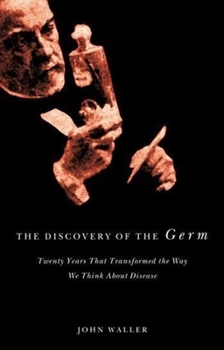The Discovery of the Germ: Twenty Years That Transformed the Way We Think about Disease
(Part of the Revolutions in Science Series)
Select Format
Select Condition 
Book Overview
From the time of Hippocrates to that of Louis Pasteur, the medical profession relied on plausible but almost wholly mistaken ideas about the causes of and best treatments for infectious illness. Bleeding, purging, and mysterious nostrums remained staple remedies, and surgeons, often wearing filthy butcher's aprons, blithely spread infection from patient to patient. Then between 1879 and 1900 came the germ revolution. After two decades of scientific...
Format:Hardcover
Language:English
ISBN:023113150X
ISBN13:9780231131506
Release Date:October 2003
Publisher:Columbia University Press
Length:200 Pages
Weight:0.55 lbs.
Dimensions:0.7" x 4.8" x 7.3"
Customer Reviews
1 rating
Delightful, short introduction to a fascinating topic
Published by Thriftbooks.com User , 15 years ago
With the ever present threats of bioterrorism and pandemics together with increasing rates of antibiotic resistant infections, this book should be of interest to many readers. As such, I found it a delightful, well-written, easy-to-read, brief introduction to the subject. The author clearly shows the difficulties experienced, scientific, theoretical and cultural, in establishing the role of germs in infectious diseases. Those opposing the role of germs are shown in many cases to have been reasonable and rational in their opposition. Many of the scientific, both laboratory and epidemiology, approaches that we take for granted today were truly creative, innovative, risky, and difficult for the early pioneers. However, I found it irritating that the book lacked an index, something I often use in finding subjects and people. I also found a couple of inconsequential minor errors. On page 190, he writes "the sulphonamides developed by Paul Ehrlich . . ." Ehrlich developed the first successful treatment for bacterial infections, syphilis and sleeping sickness; but the treatment was a variant of arsenic (his 606th tweaking of the molecule) which he named Salvarsan. German chemists during the 19th Century discovered in staining tissues for histological examination that different stains attached to different tissues. Ehrlich hypothesized that if a compound could be made that selectively targeted a disease causing organism, then a toxin could be attached to the compound, hence, a "magic bullet" would be created that killed only the organism targeted. In 1932, 17 years after Ehrich's death in 1915, Gerhard Domagk developed the first sulphonamide which successfully treated streptococcal infections for which he received the Nobel Prize in 1935. Again on page 190, the author writes, "How many of us would have gone to an early grave, were it not for the formulation of vaccines like the anti-tuberculosis jab?" The only vaccine currently used against tuberculosis, the BCG, Bacillus Calmette-Guérin, has been shown to be effective against miliary tuberculosis, a severe form found in infants and the elderly, and tubercular meningitis found in children. The verdict as to its effectiveness for preventing pulmonary tuberculosis is unclear. For those interested, I strongly recommend Frank Ryan's book, "The Forgotten Plague: How the Battle Against Tuberculosis Was Won - And Lost." There is also a quite informative article on the Bacillus Calmette-Guérin vaccine in the free online encyclopedia, Wikipedia. The errors above in no way diminish the overall strengths of the book.





